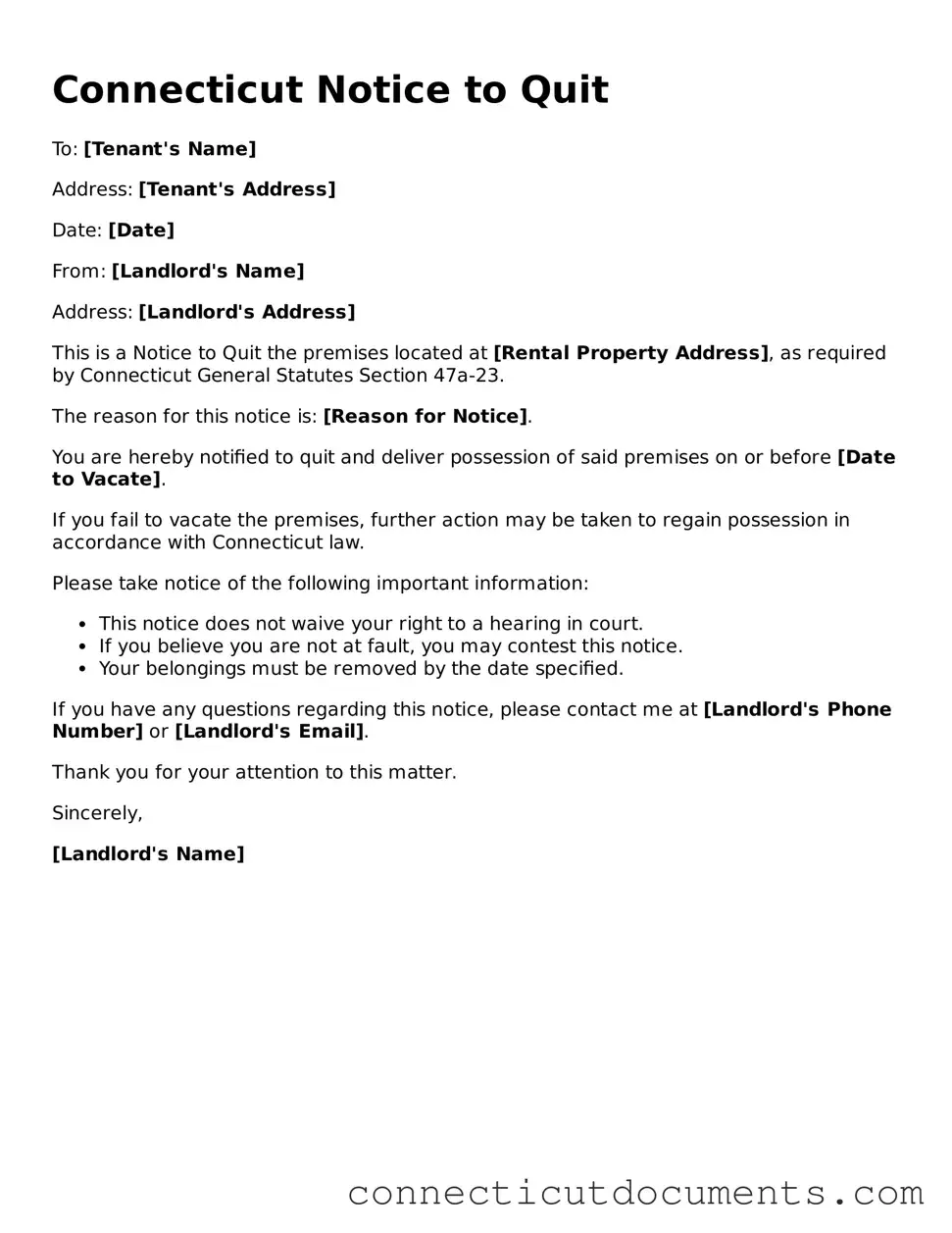The Connecticut Notice to Quit form is similar to the Eviction Notice used in many states. Both documents serve as formal notifications to tenants regarding the termination of their lease agreements. They outline the reasons for the eviction and provide a timeline for the tenant to vacate the premises. The Eviction Notice typically specifies the duration the tenant has to leave, which can vary by jurisdiction.
Another document comparable to the Notice to Quit is the Lease Termination Letter. This letter is often used by landlords to inform tenants that their lease will not be renewed. It includes essential details such as the end date of the lease and any required actions by the tenant. Both documents aim to communicate the end of a rental agreement, although the Lease Termination Letter may not always indicate a breach of contract.
The Pay or Quit Notice is also similar, as it is issued to tenants who have not paid rent. This notice informs tenants that they must either pay the overdue rent or vacate the property by a specific date. Like the Notice to Quit, it serves as a legal warning, outlining the consequences of failing to comply with the demands stated in the document.
The Three-Day Notice to Pay Rent or Quit is another related document. This notice specifically applies to tenants who have failed to pay rent within the designated timeframe. It provides a three-day window for tenants to address the unpaid rent or face eviction proceedings. Both the Three-Day Notice and the Notice to Quit are essential tools for landlords in managing rental agreements and ensuring compliance.
The 30-Day Notice to Vacate is similar in that it provides tenants with a specified period to leave the rental property. This document is often used when a landlord decides to end a month-to-month rental agreement. It outlines the required notice period and serves to inform tenants of the impending termination of their tenancy, similar to the Notice to Quit.
A Notice of Non-Renewal is also akin to the Notice to Quit. This document is issued to inform tenants that their lease will not be renewed at the end of its term. It details the reasons for non-renewal and the timeline for vacating the property. Both notices aim to communicate the end of a rental agreement, although the Notice of Non-Renewal does not imply any wrongdoing by the tenant.
The Cure or Quit Notice is another document that shares similarities with the Notice to Quit. This notice is issued when a tenant has violated a term of the lease agreement, such as having unauthorized pets. It provides the tenant with an opportunity to remedy the situation within a specified timeframe or face eviction. Both notices serve to address lease violations and outline the necessary actions for compliance.
The Connecticut Notice to Quit form is similar to the Eviction Notice used in many states. Both documents serve as formal notifications to tenants regarding the termination of their lease agreements. They outline the reasons for the eviction and provide a timeline for the tenant to vacate the premises. The Eviction Notice typically specifies the duration the tenant has to leave, which can vary by jurisdiction. Additionally, landlords may benefit from utilizing resources such as NY PDF Forms to enhance their application and eviction processes, ensuring compliance and clarity in their dealings with tenants.
The Notice of Default is similar as it is often used in the context of mortgage agreements but can apply to rental situations as well. This document notifies tenants or homeowners of a default in payment, outlining the necessary steps to remedy the situation. Both the Notice of Default and the Notice to Quit emphasize the need for prompt action to avoid further legal consequences.
The Demand for Possession is another document that resembles the Notice to Quit. This legal notice is typically used in the eviction process to demand that a tenant vacate the property. It includes specific details regarding the tenant's failure to comply with lease terms. Both documents serve as formal requests for tenants to leave the premises, often following a breach of contract.
Lastly, the Notice of Termination of Tenancy is similar in that it formally ends a tenant's right to occupy a rental property. This notice may be issued for various reasons, including lease violations or the landlord's decision to sell the property. Both the Notice of Termination and the Notice to Quit aim to inform tenants of their need to vacate while outlining the terms and conditions associated with the termination.
